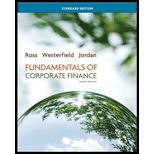
Fundamentals of Corporate Finance Standard Edition
10th Edition
ISBN: 9780078034633
Author: Stephen Ross, Randolph Westerfield, Bradford D. Jordan
Publisher: MCGRAW-HILL HIGHER EDUCATION
expand_more
expand_more
format_list_bulleted
Question
Chapter 14.4, Problem 14.4BCQ
Summary Introduction
To discuss: The reason why the cost of debt is multiplied by (1 − TC) while calculating the weighted average cost of capital (WACC).
Introduction:
The cost of capital refers to the return that the investors expect on a particular investment. In other words, it refers to the compensation demanded by the investors for using their capital.
The weighted average cost of capital (WACC) refers to the weighted average of the cost of debt after taxes and the
Expert Solution & Answer
Want to see the full answer?
Check out a sample textbook solution
Students have asked these similar questions
Which one is measurable debt burden?Select one:a. Varaiancesb. Debt per capitac. None of the other pointsd. Statistically
Is the relevant cost of debt, when calculating the WACC, theinterest rate on already outstanding debt or the rate on newdebt? Why?
Thinking about the definition of the term "flotation costs," should we expect the flotation costs for debt to be significantly lower than those for equity? Why or why not? how can the answer be supported.
Chapter 14 Solutions
Fundamentals of Corporate Finance Standard Edition
Ch. 14.1 - What is the primary determinant of the cost of...Ch. 14.1 - What is the relationship between the required...Ch. 14.2 - What do we mean when we say that a corporations...Ch. 14.2 - Prob. 14.2BCQCh. 14.3 - Why is the coupon rate a bad estimate of a firms...Ch. 14.3 - How can the cost of debt be calculated?Ch. 14.3 - How can the cost of preferred stock be calculated?Ch. 14.4 - Prob. 14.4ACQCh. 14.4 - Prob. 14.4BCQCh. 14.4 - Under what conditions is it correct to use the...
Ch. 14.5 - Prob. 14.5ACQCh. 14.5 - Prob. 14.5BCQCh. 14.6 - Prob. 14.6ACQCh. 14.6 - Prob. 14.6BCQCh. 14 - A firm has paid dividends of 1.02, 1.10, 1.25, and...Ch. 14 - Prob. 14.3CTFCh. 14 - Why is the tax rate applied to the cost of debt...Ch. 14 - What approach to a projects costs of capital...Ch. 14 - What is the flotation cost of equity for a firm...Ch. 14 - WACC [LO3] On the most basic level, if a firms...Ch. 14 - Book Values versus Market Values [LO3] In...Ch. 14 - Project Risk [LO5] If you can borrow all the money...Ch. 14 - Prob. 4CRCTCh. 14 - DCF Cost of Equity Estimation [LO1] What are the...Ch. 14 - SML Cost of Equity Estimation [LO1] What are the...Ch. 14 - Prob. 7CRCTCh. 14 - Cost of Capital [LO5] Suppose Tom OBedlam,...Ch. 14 - Company Risk versus Project Risk [LO5] Both Dow...Ch. 14 - Divisional Cost of Capital [LO5] Under what...Ch. 14 - Prob. 1QPCh. 14 - Prob. 2QPCh. 14 - Prob. 3QPCh. 14 - Prob. 4QPCh. 14 - Prob. 5QPCh. 14 - Prob. 6QPCh. 14 - Prob. 7QPCh. 14 - Prob. 8QPCh. 14 - Prob. 9QPCh. 14 - Prob. 10QPCh. 14 - Prob. 11QPCh. 14 - Prob. 12QPCh. 14 - Prob. 13QPCh. 14 - Prob. 14QPCh. 14 - Prob. 15QPCh. 14 - Prob. 16QPCh. 14 - Prob. 17QPCh. 14 - Prob. 18QPCh. 14 - Prob. 19QPCh. 14 - Prob. 20QPCh. 14 - Prob. 21QPCh. 14 - Prob. 22QPCh. 14 - Prob. 23QPCh. 14 - 24. Flotation Costs and NPV [LO3, 4]...Ch. 14 - Prob. 25QP
Knowledge Booster
Similar questions
- What are the advantages and disadvantages of short-term versus long-term debt asidentified in this section?arrow_forwardThe debt ratio may be measured in many different forms. what are they?arrow_forwardWhy is the relevant cost of debt the interest rate on new debt, not that on alreadyoutstanding, or old, debt?arrow_forward
arrow_back_ios
SEE MORE QUESTIONS
arrow_forward_ios
Recommended textbooks for you
 Intermediate Financial Management (MindTap Course...FinanceISBN:9781337395083Author:Eugene F. Brigham, Phillip R. DavesPublisher:Cengage Learning
Intermediate Financial Management (MindTap Course...FinanceISBN:9781337395083Author:Eugene F. Brigham, Phillip R. DavesPublisher:Cengage Learning

Intermediate Financial Management (MindTap Course...
Finance
ISBN:9781337395083
Author:Eugene F. Brigham, Phillip R. Daves
Publisher:Cengage Learning